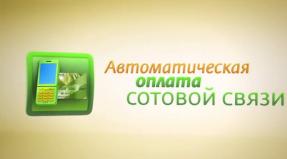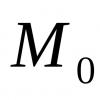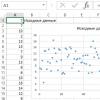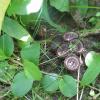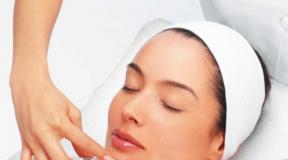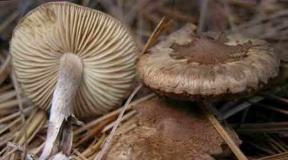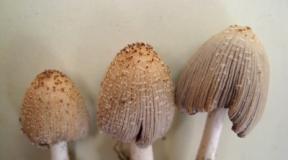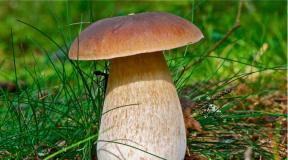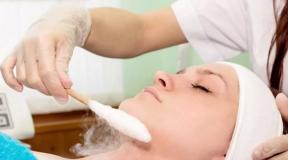Systemic antifungals. Treatment of foot fungus with drugs in tablets Broad-spectrum antifungal drugs in capsules
Mycosis or fungal infection nail plates is one of the oldest diseases. It is impossible to develop immunity to mycosis. And the only effective means of prevention is personal hygiene.
In the last half century, there has been a slight decrease in the number of fungal diseases. However, mycosis continues to maintain a leading position among all skin problems. To date, more than 400 strains of the fungus are known to attack human body. All these strains are characterized by high contagiousness and the ability to retain their pathogenic properties for a long time. The best habitat for the fungus are warm and moist surfaces. Therefore, lovers of swimming pools, saunas and baths are under attack.
A feature of mycoses is their resistance and immunity to therapeutic measures. In most cases, the patient himself is responsible for the unsuccessful treatment, who neglects his own health and does not follow all the doctor's instructions regarding treatment or arbitrarily decides to stop treatment after the first improvements.
All this leads to the development of complicated mycosis, resistant to most drugs.
Early self-diagnosis of pathogenic fungi makes it possible to defeat the disease faster and easier. The main signs of mycosis, which can be detected independently, are:
- Roughening of the skin of the feet;
- Cracks in the heels;
- Burning and itching;
- Redness of the epithelium;
- Scaly and peeling of the skin;
- Discoloration of the nail plate (formation of yellowish spots or stripes);
- Thickening of the nail plate;
- Stratification of the nail plate, change in the edge of the nail, its partial destruction.
Drug treatment of the fungus
Drugs used to treat mycosis are called antimycotics. They include a wide range of various medicines that are effective in the fight against fungus. Some of them are obtained from natural compounds, others exclusively in a chemical laboratory. All remedies for the treatment of fungus are divided into several categories or groups, depending on:
- Pharmacological composition;
- Pharmacodynamics (characteristic effect on different strains of mycoses).
All antifungal drugs have a number of contraindications and adverse reactions, therefore, the appointment and duration of admission is determined solely by a dermatologist!
When prescribing antifungal drugs for oral administration, it is important to clearly observe not only the duration of the intake, but also the frequency (you need to take the drug at the same time), avoiding skipping the drug if possible.
How do fungal pills work?
The action of broad-spectrum antifungal drugs in tablets is based on their fungicidal properties - the elimination of fungal spores and an obstacle to the reproduction of pathogenic microflora.
The antimycotic drug, when taken orally, quickly enters the bloodstream and begins an attack on the spores of the fungus. The active substance is in an active state for a long time, and then excreted naturally. Different groups of drugs for the fungus differ in pharmacological action. This is due to the components included in their composition.

Typology of effective remedies for fungus
All mycoses can be divided into two groups:
- External mycoses attack the nail plates, epithelium and hairline;
- Hidden or internal fungal pathologies affect the internal organs of a person.
In the treatment of fungal diseases are used:
- Local antibiotic against fungus;
- Capsules from the fungus of a wide spectrum of action.
When writing a prescription for a particular drug, the dermatologist takes into account clinical researches and appoints inexpensive remedy from the fungus is effective for the treatment of a particular strain of mycosis.
Groups of effective antifungal drugs
Polyenes, azoles, allylamines, pyramidins and echinocandins are isolated depending on the substances included in the composition of antimycotics, their pharmacological effects. Consider a list of the most effective remedies for fungus, presented in domestic pharmacies.
The first group of antimycotics - polyenes
Antifungal tablets of this group act on a large number of pathogenic microflora.
The polyene group of antimycotics includes:
- Nystatin;
- Levorin;
- Amphotericin B;
- Nitamycin or Pimafucin.
With the help of polyenes, they fight against candidiasis of the mucous membranes of the genital organs and larynx, epithelium, as well as fungal diseases of the stomach.

The second group of antifungal agents - azoles
Inexpensive antifungal drugs of synthetic origin.
These include:
- Ketoconazole;
- Fluconazole;
- Itraconazole.
Ketoconazole was one of the first cheap means of combating mycoses. However, due to a large number of complications, it was replaced by itraconazole and is used exclusively for local therapy. Azoles - the best means from the fungus of the epithelium, nail plates, hair and individual strains of lichen.
Ketoconazole. The active ingredient in its composition is imidazoledioxolane. An antibiotic against a fungus is effective in therapy:
- Dermatophytes;
- Yeast-like mycoses;
- Higher mycoses;
- Dimorphic mycoses.
In tablet form, ketoconazole should be drunk for diseases such as:
- folliculitis;
- Chronic form of candidiasis;
- Dermatophytosis;
- versicolor;
- Recurrent mycosis of the vagina.
Ketoconazole - effective pills from a fungus resistant to other antimycotics. Contraindications are chronic diseases internal organs. Possible side effects: allergic rashes, races blood pressure, nausea and indigestion, dizziness and drowsiness.
Itraconazole. Chemical antimycotic tablets have an effect in the body against a large number of strains of the fungus:
- Yeast mushrooms;
- Dermatophytes;
- Mold mushrooms.
With the help of itraconazole preparations, it is possible to defeat:
- Dermatomycosis;
- Vaginal and vulvocandidiasis;
- versicolor;
- Keratomycosis;
- Mycosis of the nail plates;
- Candidiasis of the oral mucosa;
- Cryptococcosis;
- Sporotrichosis;
- Blastomycosis;
- Histaplasmosis.
It is forbidden to prescribe itraconazole to women who are expecting a baby and mothers who are breastfeeding. Possible side effects: skin rashes, impaired menstrual cycle in women, vision problems.
Fluconazole. The best antifungal drug prevents the growth of fungal infections in the body and resists their replication. Effective in the treatment of such infections:

It is not used for nursing mothers, it is prescribed with caution to women who are expecting the birth of a baby and to people suffering from heart disease. Possible allergic reactions and digestive problems are associated with individual sensitivity.
A feature of taking antimycotics of the azole group is their use with food and drinking plenty of water. Incompatible with the simultaneous use of pimozide, terfenad, astemizole, quinidine, lovastatin.
The third group - alliamids
A group of synthetic fungus removers. The action of alliamids is due to the effect on dermatomycosis - fungal infections of the nail plates, hairline and epithelium.
Terbinafine. Used in therapy:
- Onychomycosis;
- hair fungus;
- Dermatomycosis of the epithelium of the body and feet.
Contraindications are chronic diseases of the liver and kidneys, for women - the period of bearing a child and breastfeeding. Occasionally, allergic reactions occur in the form of rashes, headaches, impaired taste buds, and problems with digestion. The drug is taken regardless of food. Incompatible with alcohol.
The drug for severe forms of mycosis
Griseofulvin. Effective against dermatomycetes. This is due to the natural origin of the antimycotic. This tool is called the best medicine from fungus. Griseofulvin therapy is effective even in the most severe forms of fungal diseases. However, for the treatment of mild mycotic manifestations, its appointment is not justified. Susceptible to griseofulvin are the following strains:
- epidermophyton;
- Trichophyton;
- microsporum;
- Achorionum.
It is used in the treatment of microsporia of the epithelium, hair and nails, trichophytosis, epidermophytosis, ringworm. It is not prescribed for children under two years of age, patients with oncology, chronic diseases blood and gastrointestinal tract, during pregnancy and lactation. Possible side effects on the part of the digestive and nervous system, as well as allergic manifestations caused by individual sensitivity to the components of the drug. You can take griseofulvin during or after a meal; for better absorption, the drug is combined with a tablespoon of vegetable oil.
Preparations for external fungus removal
In the treatment of mycosis of the feet and nail plates, it is first necessary to remove the keratinized exfoliated layer of the epithelium.
Keratolytic ointments such as naftalan, ichthyol, salicylic acid have a dissolving effect.
From the fungus of the epithelium, antimycotic creams, gels and ointments are used:

A good option for the treatment of onychomycosis is the application of therapeutic varnishes to the nail plate affected by the fungus - Lotseril, Batrafen. They are able to penetrate deep into the nail and continue to fight mycosis, forming a protective film on the surface of the nail.
Systemic antifungal therapy (taking drugs by mouth) is the most effective way to treat onychomycosis.
Benefits of tablets against nail fungus compared to other treatments:
- the effectiveness of therapy is higher by 80%;
- simple, convenient and labor-intensive treatment process.
Indications for systemic therapy
To treat nail fungus with pills, a number of factors must be taken into account directly. First of all, the doctor pays attention to the degree of development of the fungal infection, namely: lesion area and level of hyperkeratosis(thickening of the nail plate):
- With unexpressed hyperkeratosis and visible damage to the nail up to 30%, external antifungals.
- With mild hyperkeratosis, if the degree of damage to the nail is 30-50%, systemic drug treatment. Often, external preparations are also prescribed in the complex.
- With moderate hyperkeratosis, if the degree of damage to the nail is 50-70%, the treatment regimen is similar to the previous one. There is a possibility of insufficient effectiveness without mechanical removal of keratinized tissues.
- With severe hyperkeratosis and a lesion area of more than 50%, mandatory removal of the nail plate, cleaning of the nail bed while taking systemic drugs is indicated.

In addition to the clinical picture of the disease, the following are taken into account:
- Age and physical features(localization of onychomycosis, the rate of nail regrowth);
- Previous experience with fungus treatment, disease duration;
- Associated health problems. For example: herpes labialis, type 2 diabetes, diabetic foot- factors in favor of the appointment of systemic treatment.
Complete list of antifungal tablets
Overview of active ingredients used in preparations
 Griseofulvin is effective only for dermatophytes.
Griseofulvin is effective only for dermatophytes.
Renders fungistatic effect on fungal cells (prevents their division and reproduction). Not suitable for the treatment of onychomycosis provoked by mold and yeast species.
Is different a high degree absorption. Metabolized by the liver, toxic.
The maximum concentration reaches 4-5 hours after ingestion.
Systemic treatment is carried out until the healthy nail grows completely, because after stopping the drug, the concentration decreases sharply within 2 days.
The average duration of therapy depends on the localization of onychomycosis: fingernails up to 6 months, on the legs 9-18 months.
Dosage forms: 125 mg, 250 mg, 500 mg tablets or oral suspension.
Dosage: on average, at the rate of 10 mg / 10 kg of body weight, i.e. 500-1000 mg of griseofulvin per day for adults and 125-500 mg for children. The last group of patients is not recommended to prescribe the drug. Consume after meals for better absorption.
Interacts with other drugs: weakens the effect of cyclosporine, anticoagulants, and hormonal contraceptives.
Adverse reactions: nausea, vomiting, diarrhea, hepatitis, dizziness, sleep disturbances.
Contraindications: pregnancy and lactation, childhood, liver and kidney diseases, systemic blood diseases.
 The preparation of the allylamine group has a fungistatic (inhibition) and fungicidal (destruction) effect on dermatophytes and some mold fungi (Trychophyton spp., Microsporum canis, gypseum, Epidermophyton floccosum). Not effective enough against yeast species. The mechanism of action is aimed at destruction of the fungal cell membrane.
The preparation of the allylamine group has a fungistatic (inhibition) and fungicidal (destruction) effect on dermatophytes and some mold fungi (Trychophyton spp., Microsporum canis, gypseum, Epidermophyton floccosum). Not effective enough against yeast species. The mechanism of action is aimed at destruction of the fungal cell membrane.
It is easily absorbed in the intestines, partially metabolized by the liver, and reaches its maximum concentration in a matter of hours. In the required amount, it accumulates in the nails after 3-8 weeks of administration and persists for a long time after discontinuation of the drug.
Available in the form of tablets of 125 mg and 250 mg.
The course of admission for treatment on the hands is 4-6 weeks, on the legs - 12 weeks. For adults daily dose drug 250 mg, for children 62.5 mg for every 20 kg of weight.
Concurrent use of rifampicin, cimetidine affect the metabolism of terbinafine and require adjustment of the dosage of the drug.
Side effects: nausea, abdominal discomfort, loss of appetite, changes in taste.
 Ketoconazole from the azole group is active against dermatophytes and yeast fungi(Trichophyton, Epidermophyton floccosum, Microsporum, Candida). fungistatically acts on the pathogens of onychomycosis, destroys the cell membrane of the fungus.
Ketoconazole from the azole group is active against dermatophytes and yeast fungi(Trichophyton, Epidermophyton floccosum, Microsporum, Candida). fungistatically acts on the pathogens of onychomycosis, destroys the cell membrane of the fungus.
Absorption by the intestines is partial, decreases with weak acidity, it is recommended to take it simultaneously with food. It enters the nail plate on average 1.5 weeks after the start of the intake. It has no properties to linger in the tissues after the end of consumption.
Dosage form: 200 mg tablets.
Dosage: the average rate for an adult is 200 mg per day for a course of 4-6 months and 8-12 months for the treatment of fungus on the hands and feet, respectively. For children weighing up to 30 kg, half the dose is sufficient.
Interactions with other drugs: rifampicin reduces the concentration of ketoconazole, and drugs to reduce gastric secretion interfere with absorption. Ketoconazole is not recommended to be taken simultaneously with antihistamines, anticoagulants.
May cause nausea, vomiting, abdominal discomfort.
Contraindicated in lactating and pregnant women, children under 3 years of age, with liver disease.
 A modern representative of azoles. Differs in a wide spectrum of action: destroys cells of dermatophytes, yeasts and most molds.
A modern representative of azoles. Differs in a wide spectrum of action: destroys cells of dermatophytes, yeasts and most molds.
It is well absorbed in the intestines. 7 days after the start of the intake, it accumulates under the nail, in the very focus of the infection. With each dose of the drug, the concentration increases several times. After cancellation, it remains in the tissues for a long period of time. Often used as part of pulse therapy: 400 mg / day for a week, followed by a break. For the treatment of toenails, on average, 3 courses of therapy are prescribed with an interval of 3 weeks. On hand - 2 courses with a similar interval.
Dosage form: capsules of 100 mg of the drug.
Interacts with other drugs, has a list of contraindications for the combination.
Side effects: nausea, constipation, abdominal pain, menstrual irregularities, dizziness.
Contraindicated in women during pregnancy (1 trimester) and lactation, with cardiac pathologies, impaired liver and kidney function.
 Fluconazole works similarly to other drugs of the azole group. Has a wide spectrum of activity against dermatophytes and yeasts. In relation to mold species, the effectiveness is low.
Fluconazole works similarly to other drugs of the azole group. Has a wide spectrum of activity against dermatophytes and yeasts. In relation to mold species, the effectiveness is low.
Rapidly absorbed, practically not metabolized in the liver. Peak concentration occurs within the first hours after ingestion. It gets into the nails quickly, on average within a day.
Available in the form of capsules with a gelatin shell of 50, 100 and 150 mg
As part of pulse therapy, 150-300 mg is prescribed once a week for up to 6 months for onychomycosis of the hands and up to 12 months for the legs.
Taking rifampicin reduces the concentration of the antimycotic. And fluconazole itself increases the concentration of cyclosporine and phenytoin.
Adverse reactions due to a single dose per week usually do not occur.
Choosing the most effective drug
The optimal drug for systemic therapy is prescribed by the doctor based on the results of determining the type of fungus, localization and severity of the disease.
Main selection criteria:
- Type of pathogen fungus. There are no universal tablets for the treatment of onychomycosis. All active ingredients show different effectiveness against different types of fungi. With dermatophytes, griseofulvin and terbinafine are prescribed.
- With dermatophytes and / or yeast fungi of the genus Candida - azoles (ketoconazole and fluconazole).
- If there are several causative agents of the disease, then broad-spectrum drugs are prescribed. The most effective against all itraconazole and its analogue derivatives.
- Localization of onychomycosis and severity of the disease. Grisefulvin and ketoconazole are not used for a long course due to high toxicity. It is mainly prescribed for the treatment of onychomycosis of the initial, middle stage, with localization on the hands.
Terbinafine and Itraconazole are relatively harmless and highly effective, suitable for the treatment of onychomycosis on the legs, as well as in advanced cases that require a longer course of therapy. - Contraindications. The choice of drug depends largely on general condition health of the patient, it is necessary to carefully study the contraindications and side effects before using antimycotics of any group.
Main contraindications
- pregnancy and lactation;
- childhood;
- diseases of the liver, kidneys;
- disorders of the nervous system;
- cardiovascular diseases.
Possible Complications
 Antimycotics are toxic, have a particularly strong effect on the liver. In order to avoid complications, the medication should be taken under the supervision of a doctor. In parallel, hepatoprotectors are prescribed - drugs to protect and restore liver cells (Karsil, Essentiale Forte, Phosphogliv, Gepabene).
Antimycotics are toxic, have a particularly strong effect on the liver. In order to avoid complications, the medication should be taken under the supervision of a doctor. In parallel, hepatoprotectors are prescribed - drugs to protect and restore liver cells (Karsil, Essentiale Forte, Phosphogliv, Gepabene).
Alternatives to Systemic Therapy
There is no absolute alternative to systemic treatment due to its high efficiency. But in case of serious contraindications, the fungus can be cured without pills. Gives a similar effect:
- , with normotrophic onychomycosis;
- means for local therapy in combination with mechanical in hypertrophic onychomycosis.
The optimal treatment regimen is prescribed exclusively by a doctor. Due to the toxicity of antimycotic drugs, self-medication is dangerous to health.
Nail fungus is considered one of the most common diseases, and its treatment requires the use of various medications. It is simply impossible to form immunity to such a disease, and the main preventive method maintenance of personal hygiene is considered. To combat pathology, various antifungal drugs have been created in the form of ointments, tablets, creams, varnishes and sprays.
In the absence of a positive effect after local treatment of the affected areas of the skin, therapy with oral and systemic medications is selected. The use of the latest antifungal agents allows not only to cope with the disease, but also to prevent its occurrence in the future.
The first signs of mycosis attack
Timely diagnosis allows you to start mycosis therapy as early as possible and choose an antifungal agent. There are special signs of mycosis, which may indicate a disease:
- coarsening of the skin on the legs;
- the appearance of cracks in the heel area;
- staining of the epithelium in red;
- thickening of the nail plate;
- severe exfoliation of the epidermis;
- the formation of yellow spots or stripes on the nails;
- severe itching and burning.
With the disease, stratification of the nail, changes in the boundaries of its edge and partial destruction of the plate are noted.
Drug treatment of the fungus
Antifungal agents that are used to treat mycosis are called antimycotics. This term is used to unite different types medicines against the fungus, which are characterized high efficiency in treatment. Some types of external fungus removers are obtained only in chemical laboratories, while others are obtained from natural compounds. All medications for the treatment of fungal lesions are classified into the following groups, taking into account:
- pharmacological composition;
- features of the effect of the drug on individual strains of fungi.
All antifungal drugs in the form of tablets have certain contraindications to their use and can provoke adverse reactions. Given this feature, they can only be prescribed by a dermatologist. In addition, it is the specialist who determines the dosage of broad-spectrum antifungal drugs in tablets and the duration of their use.
In the event that the patient is prescribed oral medication, it is necessary to observe the duration of the intake and a certain frequency. This means that you need to use the remedy at the same time for treatment, avoiding gaps and in no case doubling the dose. The fact is that a violation of the sequence of treatment or its premature completion can cause the re-development of the fungus of the feet and nails. Only a specialist can choose the most effective remedy for a fungus.

How do fungal pills work?
The effectiveness of drugs with an antifungal effect, produced in tablet form, is based on their fungicidal properties. This means that antifungal tablets accelerate the elimination of mycosis spores and inhibit the further reproduction of pathogenic microflora.
When taken orally, the antimycotic agent penetrates into the blood in a short time and actively affects the spores. In the human body, the active ingredient remains in an active state for a long time, after which it is naturally excreted. There are different groups of medicines that differ from each other in pharmacological features. In the treatment of fungal infections can be used the following drugs:
- Antibiotic antifungal drugs in tablet form, in which the main component is ketoconazole. With their help, it is possible to slow down the formation of the membrane of the pathogen at the cellular level.
- Preparations for mycosis with terbinafine and itraconazole. Such agents disrupt the production of ergosterol and thereby prevent the reproduction of pathogenic cells.
- Medicines containing fluconazole. With their help, it is possible to destroy the cells of the pathogen, and prevent the formation of new ones.
- Griseofulvin tablets for internal use help to avoid division of spores and further progression of the disease.

Typology of effective remedies for fungus
All lesions of the skin specialists are divided into the following groups:
- outdoor fungal diseases affecting the hairline, epithelium and nails;
- internal or hidden mycoses attacking internal organs.
In the treatment of pathologies of fungal etiology, the following are usually used:
- local antibacterial antifungal agent;
- antifungal agents with a wide spectrum of action, designed to destroy the fungus.
Before prescribing antifungal therapy, clinical trials must first be carried out, according to the results of which the most effective remedy against a particular strain of mycosis is selected. In the treatment, griseofulvin is especially effective, helping to quickly destroy the spores of the fungus.

Groups of effective antifungal drugs
Antifungal tablets are divided according to their chemical structure, spectrum of action and clinical purpose. All modern antifungal drugs for human oral administration are conditionally divided into several groups with the following names:
- polyenes;
- azoles;
- alliamids.
- pyrimidines;
- echinocandins.
Some fungi develop resistance faster than others to certain broad-spectrum antifungal tablets. It is for this reason that incomplete drug treatment can lead to the fact that the next time you have to prescribe a medication with a different active ingredient.
Important! Preparations in tablets and solutions must be used in a strict dosage, selected by the doctor. The duration of therapy is determined by the form of the drug and composition.
The first group of polyene antimycotics
Polyenes are strong, powerful, versatile antifungals that come in tablet and ointment form. They are mainly prescribed for the treatment of candidiasis of the skin, mucous membranes and gastrointestinal tract. The following drugs of the polyene group are considered the most effective in the fight against the disease:
- Nystatin;
- Levorin;
- Pimafucin.
Thanks to the antimycotics of this group, candidiasis of the genital mucosa is treated and epithelial tissue, as well as fungal infections of the stomach.

The second group of antifungal agents - azoles
Azoles are modern antifungal drugs that are used to treat mycoses of the scalp, skin, nails and lichen. Some medicines of this group are prescribed for the treatment of candidiasis of the mucous membranes and thrush. The fungicidal properties of azoles are manifested in the destruction of fungal cells, and a positive effect can only be achieved at high concentrations of antimycotics.
This group of drugs is considered the most effective, and its representatives are:
- Ketoconazole. The drug is based on the active ingredient with the same name. Ketoconazole is prescribed for the treatment of yeast-like mycoses, dermatophytes, a chronic form of candidiasis and multi-colored lichen. The use of the drug can cause adverse reactions, and any pathology of the kidneys and liver is considered a contraindication to therapy.
- Itraconazole. such tablets are effective against yeasts and molds, as well as dermatophytes. Intraconazole is found in preparations such as Orungal, Orunit, Irunin, Itramikol and Canditral.
- Fluconazole. Such an antifungal drug is considered one of the best against the disease, and helps to stop the growth of mycoses in the human body. The drug is prescribed for the treatment of candidiasis, dermatophytosis and deep mycoses. As an active ingredient, fluconazole is contained in drugs such as Diflazon, Mikoflyukan, Diflucan, Flucostat and Fungolon.

The third group - alliamids
Antifungal agents of the alliamid group are effective in the treatment of dermatomycosis - fungal infections of the skin, nails and hair.
The most common drug in this group is Terbinafine, which has a fungistatic and fungicidal effect. The medicine helps in the fight against dermatophytosis, candidiasis, chromomycosis and deep mycoses.
An antifungal drug that contains active substance naftifine, is a cream and solution Exoderil. Such a tool is used for the treatment of nails and skin, and the inflamed area of \u200b\u200bthe skin is lubricated once a day.
The drug for severe forms of mycosis
For the treatment of complicated mycotic forms, such a broad-spectrum antifungal drug in tablets as Griseofulvin can be prescribed. It is used to eliminate microsporia of hair, epithelium and nails, as well as to combat trichophytosis, ringworm and epidermophytosis. A contraindication to treatment with such a mycotic drug is children under 2 years of age, oncological pathologies, pregnancy and period breastfeeding. Adverse reactions may appear in the work of the digestive and nervous systems, and allergies are also possible.

Preparations for external fungus removal
For the treatment of epithelial fungus, the following fungicidal antifungal drugs of systemic action can be prescribed:
- Lotriderm;
- Triderm;
- Seacorten;
- Sinalar;
- Travocort.
efficient medicine therapeutic varnishes Lotseril and Batrafen are considered, which should be applied to the affected nail plate. They quickly penetrate the human nail, effectively fight the disease and form a protective film on its surface. For local therapy of mycosis, it is recommended to use antimycotic shampoos such as Mycozoral, Cynovit and Sebiprox.
It is possible to completely get rid of the fungus only with the help of complex treatment chosen by the doctor. It involves taking oral medicines, increasing the body's immunity and local treatment of damaged areas of the epithelium.
At the moment, about five hundred varieties of representatives of the kingdom of fungi are known, but not all of them are dangerous, some representatives are conditionally pathogenic.
The pathogenicity of fungi is determined by their ability to influence the tissues of the organ and cause structural changes in the cell wall and metabolic processes in them. At the same time, the pathological fungal flora is able to synthesize individual toxic compounds, among which are:
- aflatoxins;
- phallotoxins;
- various proteo- and lipolytic enzymes.
All of the above chemical compounds contribute to the destruction of tissue and cellular components of the affected tissue or organ.
What is this article about?
Mechanisms of action of antimycotic agents
The development of pathogenic flora and its damage to the body is observed with a decrease in protective functions. A fungal infection most often damages the skin, nail plates and, in rare cases, the hairline area and internal organs of the body.
The advanced form of mycotic infection is much more difficult to treat than the disease on initial stage development. For this reason, pathology should be detected in a timely manner and adequate therapeutic measures should be taken.
Antimycotics are prescribed depending on:
- Localization of the affected area.
- type of pathology.
- The spectrum of action of an antifungal agent.
- Features of the pharmacokinetics and toxicity of the drug.
Depending on the affected area, fungi are divided into:
- affecting the upper layer of the skin without the development of inflammatory processes;
- damaging the stratum corneum and provoking the appearance inflammatory process in the underlying layers of the skin;
- damaging the skin, subcutaneous tissue, muscle structures, bones and internal organs.
The most common is the development of fungal infections belonging to the first two groups of diseases. Such ailments are keratomycosis, dermatomycosis and subcutaneous mycoses.
The main active components of antimycotic drugs.
Means with a wide spectrum of action have a fungistatic and fungicidal effect. Due to the presence of these properties, drugs contribute to the creation of conditions in the body for the destruction of fungal pathogens.
As a result of the fungistatic effect of antimycotics, the processes that ensure the reproduction of the pathogen in the body are suppressed.
The active components of systemic antifungal agents, entering the bloodstream, are carried throughout the body and destroy fungal spores. The active components of such drugs are in the human body for a long period of time, and the metabolic products active ingredient excreted mainly by the excretory system in the urine.
Each group antifungal medicines has an individual mechanism of action, which is due to the difference in the set of active active ingredients.
Antimycotic drugs can be classified according to chemical composition, features of the spectrum of activity, pharmacological properties and clinical use.
The following main groups of drugs are distinguished:
- Preparations containing ketoconazole in their composition.
- Means with itraconazole.
- Medicines containing fluconazole.
- Medicines with terbinafine.
- Pharmaceutical preparations with griseofulvin.
When using any antimycotic, it is required to strictly follow the instructions for use and the recommendations of the attending physician, which is associated with the presence of high toxicity of drugs not only in relation to pathogenic fungal flora, but also to the body as a whole. When carrying out therapeutic measures, it is prohibited to interrupt the ongoing therapy without receiving instructions from the attending physician.
Reception of antifungal drugs is carried out at the same time with a meal and at the same time, they should be washed down with a sufficient amount of water.
If the patient has reduced acidity, then he is forbidden to take funds belonging to the group of azoles.
If you can’t do without the use of drugs in this group, then in parallel with them, you need to take oxidizing liquids, for example, orange juice.
Classification of antifungal compounds
For treatment various kinds fungal infection, drugs belonging to different pharmacological groups are used. In the case of a running form, systemic antimycotics are used to carry out therapeutic measures.
Before prescribing a medication belonging to a particular group for antifungal measures, the doctor conducts an examination to identify the type of fungus that has affected the patient's body, and only after its exact determination is an antifungal composition prescribed for treatment.
To determine the pathogen, a microscopic examination of the biomaterial obtained in the lesion is carried out. So biological material may be a smear of the mucous membrane of the throat, scales of the skin taken in the infectious focus, etc. After receiving the results of the examination, the doctor selects the composition and its appropriate dosage, taking into account the characteristics of the patient's body.
At present, there are several pharmacological groups antifungal agents:
- polyenes;
- azoles;
- allylamines.
Each of these pharmaceutical groups has its own characteristics of application and pharmacological properties, due to the main active ingredient used.
Characteristics of the azole group
The azole group is a large variety of medicines designed to combat fungal infections. This category of medicines includes both systemic and local agents.
Azoles are characterized by the presence of a fungistatic property, which is associated with the ability to inhibit cytochrome P-45 dependent demethylase, which catalyses the process of converting lanosterol to ergosterol, which is the main component of the cell membrane.
Topical formulations are capable of exerting a fungicidal effect.
The most common systemic drugs are:
- Fulconazole.
- Itraconazole.
Azolami local application are:
- Bifonazole;
- Isoconazole;
- Clotrimazole;
- Miconazole;
- Oxyconazole;
- Econazole.
It should be noted that after the synthesis of Intraconazole, a new generation drug, Ketoconazole has lost its significance as a component used for the treatment of fungal pathologies, due to its high toxicity. At the moment, this medication is more often used for local therapy.
When using systemic azoles, the patient may experience the following adverse reactions:
- Pain in the abdomen.
- Appetite disorders.
- Feelings of nausea and urge to vomit.
- Diarrhea or constipation.
- Headaches.
- Vertigo.
- Drowsiness and visual disturbances
- Tremors and convulsions.
- Allergies in the form of itching, dermatitis.
- thrombocytopenia.
In the case of the use of formulations for therapeutic interventions at the local level, the following may develop: side effects:
- itching;
- burning sensations;
- hyperemia;
- swelling of the mucosa.
The indication for the use of Intraconazole is the presence of ringworm and pityriasis versicolor. Candidiasis of the esophagus, skin and mucous membranes, nails, vulvovaginitis, cryptococcosis, chromomycosis and endemic mycoses. In addition, the medication is used to prevent mycoses in AIDS.
Fluconazole is used to treat invasive candidiasis, condidiasis of the skin and mucous membranes, ringworm, pityriasis versicolor and some other pathologies.
Ketoconazole is prescribed in the treatment of skin candidiasis, pityriasis versicolor. Dermatomycosis and other ailments.
Azoles for topical use are prescribed for the treatment of dermatomycosis, pityriasis versicolor and erythrasma. The appointment of this group of drugs for the treatment of onychomycosis is ineffective.
Polyene antifungals
Polyenes are natural antimycotics. This type of antifungal drugs include Nystatin, Levorin, Natamycin, and Amphotericin B.
The first three medicines are prescribed both internally and externally, and last drug of this group has found application in the treatment of severe systemic infections with fungal flora.
The effect on the body depends on the dosage used and can be manifested by fungistatic and fungicidal effects. This effect of the funds is due to the ability of the drug to bind to ergosterol, which is part of the cell membrane of the fungal cell.
When taking polyenes, the following undesirable reactions may develop:
- Pain in the abdomen.
- Feeling of nausea, vomiting and diarrhea.
- Allergy in the form of a rash, itching and burning.
Polyenes are used to treat candidiasis of the skin, severe forms of systemic mycoses, and endemic fungal infections.
Contraindications to the use of this type of medication are allergic reaction on components, disorders in the functioning of the kidneys and liver, the presence of diabetes. All these contraindications are relative, so the use of drugs can be carried out according to health indications.
The main characteristic of allylamines
 Allylamines are synthetic anti-fungal agents. Pharmaceutical preparations are used to combat onychomycosis, fungus of hair, skin and for the treatment of lichen.
Allylamines are synthetic anti-fungal agents. Pharmaceutical preparations are used to combat onychomycosis, fungus of hair, skin and for the treatment of lichen.
Allylamines are characterized by the presence of a wide spectrum of action. The active components of this group are capable of destructively affecting the structures of the shell of spores of a pathogenic fungus.
When using a low dosage of medicines of this variety, it is possible to treat infections of dimorphic and mold fungi.
The list of drugs of this variety includes:
- Terbizil;
- Lamisil;
- Exiter.
In the process of use, allylamines have a fungicidal effect, which is associated with a violation of the reactions of ergosterol synthesis. Preparations containing allylamines can block early stages biosynthetic processes by blocking squalene epoxidase.
When using medicines of this variety, the following undesirable and adverse reactions may occur in a patient:
- Pain in the abdomen.
- Change in appetite.
- Nausea and vomiting.
- Diarrhea.
- Loss of sense of taste.
- Headaches and dizziness.
- Allergy, manifested in the form of a rash, urticaria and exfoliative dermatitis.
In addition, the development of neutropenia and pancytopenia, an increase in transaminase activity and the development of liver failure are possible.
What medicines to use for a fungal infection?
The choice of a drug for the treatment of fungus is carried out by the attending physician only after examining the patient and establishing an accurate diagnosis. The physician takes into account clinical picture diseases and individual characteristics of the patient's body.
Unauthorized appointment and completion of antimycotic therapy is strictly prohibited. It is also forbidden to replace one composition prescribed by the attending physician with another remedy, even if the medication is an analogue of the medicine that was prescribed by the doctor.
Antimycotics for body skin
Dermatomycosis is one of the most common mycotic diseases. It can affect the skin of the body in the head, arms, legs and abdomen.
A huge number of various medicines have been developed to combat this pathology. The most common and popular are Nystatin, Fluconazole, Itraconazole, Clotrimazole and Ketoconazole.
Nystatin is used in medical practice not only to treat a fungal infection of the skin, it has proven itself well when prescribed to cure candidiasis of the vagina, oral cavity and intestines.
Fluconazole is used in the detection of candidiasis of various organs. This medication belongs to the second generation of antimycotics, when it is prescribed, a negative effect on the functioning of the liver is possible, but after the end of antifungal therapy, the liver is able to restore its functionality in full.
Itraconazole is intended for oral administration, is available in the form of capsules and is used to treat skin mycosis, candidiasis and onychomycosis. In some cases, its use is recommended as an effective prophylactic drug against mycotic infection if a person has AIDS.
Clotrimazole can be prescribed during activities aimed at curing the fungus, lichen and trichomoniasis. This composition has a high degree of efficiency at a relatively low cost.
Antifungal medicines for candidiasis and nail fungus
If signs of candidiasis are detected, the attending physician recommends the use of drugs local action. If there is acute form a fungal infection is prescribed medication with a wide spectrum of effects.
For this purpose, such medicines are used. Like Pumafucin, Clotrimazole and Diflucan. All of these drugs have a high degree of effectiveness in the fight against mycotic infection.
If nail fungus is detected at the initial stage, the dermatologist recommends treatment with solutions, ointments, special varnishes and gels.
If the lesion of the plate is registered on most of it, then you should pay attention to medications in tablet form and having a wide spectrum of action. Choosing the right medicinal composition handled by the attending physician. He makes his choice on the basis of the distribution and stage of development of the pathology and the individual characteristics of the human body.
Most effective means in the fight against onychomycosis are Fluconazole, Ketoconazole, Itraconazole, Flucostat and Terbinafine.
General recommendations when using antifungal formulations
Any kind of mycotic infection is serious illness requiring a systematic and integrated approach to the implementation of therapeutic measures.
Medical experts do not recommend self-administration of antimycotics for the treatment infectious disease, this is due to the fact that most drugs can have a negative toxic effect on the patient's body.
In addition, almost all antimycotics are capable of provoking the appearance of a whole range of side and negative effects in the body.
The selection of drugs for treatment and the determination of their dosage should be carried out by the doctor who diagnosed the pathology in accordance with the characteristics of the course of the disease and the individual characteristics of the body of the patient infected with a fungal infection.
When choosing a drug for therapeutic measures, it should not be based only on patient reviews about it, the use of any antimycotic drug is allowed only after consultation with the attending physician, and the treatment itself must be carried out with strict adherence to the instructions for use and doctor's recommendations.
fungal infection is common cause doctor visits different specialties. In some cases, it becomes a threat to the patient's life and requires immediate treatment, in others, mycosis can only cause discomfort and a feeling of embarrassment in front of others. Many oncological and systemic diseases are treated with aggressive drugs that suppress the immune system and cause the reproduction of a pathogen that only antifungal drugs can eliminate. Therefore, it is important to recognize the infection in a timely manner and begin its treatment, and in some cases, prevent infection.
Antimycotics are represented by a wide variety of drugs. These are predominantly broad-spectrum drugs, many of which are effective not only against pathogenic fungi, but also against other microbes. They are prescribed by a doctor after the diagnosis is established and taken until complete cure from infection.
Types of antifungals
Antimycotics are available in the following dosage forms:
- topical products in the form of cream, gel, ointment, spray and drops;
- oral preparations in the form of capsules, tablets or syrup;
- solutions for intravenous infusions;
- intravaginal tablets.
Adverse reactions
Antifungal medicines can cause side effects. They usually only last for a short period of time. These include:
- itching or burning;
- redness;
- abdominal pain;
- diarrhea;
- rash on the skin.
Some drugs have more serious side effects. When taking them, the patient may develop anaphylactic shock or angioedema: the face, neck or tongue swell, breathing may be difficult, blisters appear on the skin.
In case of an overdose, as well as in patients with liver diseases, liver failure may develop, in which the patient complains of the following symptoms:

Polyena
This is a group of drugs of natural origin. The main substance is obtained from bacteria of the genus Streptomyces. Upon contact with the fungus, it interacts with ergosterol, which is part of the plasma membrane, as a result of which a channel is formed in the wall, respiratory processes are disrupted and the cell dies. Polyene antifungals include:
- Nystatin;
- Amphotericin B;
- Pimafucin.
Nystatin
Antimycotic agent effective against fungi of the genus Candida.
Nystatin is used for local infection, candidiasis of the oral cavity, mucous membranes, skin, and internal organs. In systemic diseases, it is not used.
 The drug is available in the form of tablets, ointments, suppositories. It has low toxicity, rarely causes side effects, therefore it is approved for use in children. When taken, the medicine increases sensitivity to ultraviolet rays, therefore, during therapy, prolonged exposure to the sun should be avoided. Since sugar is present in the composition, the drug is contraindicated in patients with gastrointestinal enzyme deficiency.
The drug is available in the form of tablets, ointments, suppositories. It has low toxicity, rarely causes side effects, therefore it is approved for use in children. When taken, the medicine increases sensitivity to ultraviolet rays, therefore, during therapy, prolonged exposure to the sun should be avoided. Since sugar is present in the composition, the drug is contraindicated in patients with gastrointestinal enzyme deficiency.
Amphotericin B
A drug with a wide spectrum of activity, which is used to treat both severe fungal systemic diseases and local mycoses.
The drug can be taken by pregnant women, but with caution, lactation should be stopped for the duration of treatment. Do not use in patients with kidney and liver damage.
It is used externally as an ointment or intravenously. The introduction of the drug intravenously can be accompanied by a considerable number of side effects: from phlebitis (inflammation of the vein) in the area of drug administration to toxic action on the liver and kidneys. 
Azoles
The chemical structure of these agents includes two or three nitrogen molecules. Depending on the amount of this element, they are divided into imidazoles and triazoles. The imidazoles are:
- Ketoconazole;
- Miconazole;
- Clotrimazole.
A derivative of imidazole and benzothiophene is Zalain.
Triazoles are represented by two names:
- Fluconazole;
- Itraconazole.
The mechanism of action of this group of drugs is expressed in the inhibition of enzymes dependent on cytochrome P450, which are involved in the biosynthesis of cell membrane sterols. This leads to a violation of the integrity of the fungal cell. 
The range of action of drugs in this group is wide, and side effects are less common compared to polyene antibiotics. But with long-term use of azoles, life-threatening liver failure can occur.
It is more commonly caused by imidazoles than by triazoles. It is not recommended to take azoles together with medicines such as:
- Cyclosporine;
- antihistamines;
- oral hypoglycemic agents;
- anticoagulant drugs;
- drugs that are metabolized in the liver.
Ketoconazole
A good antifungal drug that is widely used in dermatology. Effective when taken in tablet form, but it can also be used topically. Available in the form: 
- ointments;
- tablets;
- shampoo.
Active against infections caused by H. capsulatum and B. dermatitidis. The medicine is prescribed for the treatment of:
- thrush;
- dermatomycosis;
- nail fungus;
- ringworm;
- mycosis of the genitourinary organs.
The drug can be used with preventive purpose to prevent infection.
Fluconazole
It is used for mycoses of external localization and systemic fungal infection. Available as:
- capsules;
- syrup;
- solution for infusion.
One of the main indications for use is candidiasis of different localization (skin, genital area, oral cavity). The drug is well tolerated, side effects are rare, manifested by skin rash, diarrhea. Not recommended for use by children and pregnant women.
Itraconazole
An inexpensive antifungal drug that is prescribed for mycotic lesions of the skin, mucous membranes, and nail plates.
 The drug is presented in the form of capsules for oral administration. It is not recommended to use Itraconazole in patients with medical conditions of cardio-vascular system, hepatic and kidney failure. During pregnancy and lactation, you can not take the medicine. Side effects may include:
The drug is presented in the form of capsules for oral administration. It is not recommended to use Itraconazole in patients with medical conditions of cardio-vascular system, hepatic and kidney failure. During pregnancy and lactation, you can not take the medicine. Side effects may include:
- allergic reaction;
- the phenomena of dyspepsia;
- headache;
- dizziness.
Of the more severe complications, there is a possibility of developing heart and liver failure.
Zalain
A modern medicine of a new generation of a wide spectrum of action. It is used to combat the fungus of external localization and vaginal candidiasis.. Available in the form of ointments and suppositories. Zalain practically does not cause side effects and does not have a systemic effect on the body. Not recommended for pregnant and lactating women. The result after the start of application is noticeable almost immediately. 
Allylamines
This group of antimycotic agents is represented by two drugs: Terbinafine and Naftifine. They are used for fungal diseases of external localization (onychomycosis, skin fungus).
Terbinafine
Terbinafine effectively fights against pathogenic fungi and has an antibacterial effect.
In the pharmacy, the medicine can be found in the form of tablets, spray, cream and solution for external use. The drug is approved for children over 2 years of age.
Adverse reactions are minimal, patients may complain of:

Naftifin
This antimycotic is used for external use for skin fungus, damage to the nail plates. Contraindicated in case of allergy to drug components. Pregnant women should be used with caution, children are not prescribed.
Side effects are predominantly local in nature: rash, itching, burning in the areas of application.
Morpholine derivatives
This group is represented by one drug - Amorolfine. The drug is inexpensive, but correct application effective. Available as nail polish, cream and spray. The drug gives the most reliable result with onychomycosis.
- children (studies on the effect of the drug on children's body not carried out);
- pregnant and lactating;
- people with hypersensitivity to the drug.
Undesirable reactions can be manifested by rashes on the skin, itching. 
Other antifungals
Based on the results of the tests, the doctor may prescribe antimycotics from other chemical groups.
Griseofulvin
An antifungal medicine derived from the bacterium Penicillium griseofulvum. Produced in the form of tablets. It is prescribed for mycoses of the skin, feet, scalp.
Contraindications for use are:
- systemic diseases;
- damage to the kidneys and liver;
- oncological diseases;
- age up to 2 years;
- pregnancy and lactation.
The drug reduces the effectiveness of hormonal contraceptives and anticoagulants of indirect action.

flucytosine
This medicine is an antimetabolite that has fungicidal and fungistatic effects. Its mechanism of action is to inhibit the synthesis of DNA and RNA in the fungal cell.
The medicine is effective for:
- severe systemic diseases;
- fungal meningitis;
- candidiasis;
- cryptococcosis;
- aspergillosis.
Flucytosine is contraindicated:
- during pregnancy;
- during breastfeeding;
- in childhood;
- people with blood diseases and kidney failure.
The drug is used as an infusion for intravenous administration. It can have a large number of side effects, some of which are serious life-threatening:
- cardiac arrest, breathing;
- gastrointestinal bleeding;
- liver failure.
Therefore, a medicine is prescribed according to strict indications and its intake should be under the supervision of a doctor.
Before using any of the drugs, you need to read the instructions, and if unwanted reactions occur, immediately contact your doctor.
